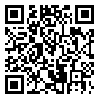Volume 31, Issue 1 (4-2022)
JGUMS 2022, 31(1): 40-49 |
Back to browse issues page
Ethics code: IR.GUMS.REC.1399.481
Download citation:
BibTeX | RIS | EndNote | Medlars | ProCite | Reference Manager | RefWorks
Send citation to:



BibTeX | RIS | EndNote | Medlars | ProCite | Reference Manager | RefWorks
Send citation to:
Asadi P, Noori Roodsari N, Eslami Kenarsari H, Darabi Niya M R, Pourshaikhian M. Knowledge Level of Pre-Hospital Emergency Medical Services Personnel about Ambulance Equipment in Rasht, Iran. JGUMS 2022; 31 (1) :40-49
URL: http://journal.gums.ac.ir/article-1-2358-en.html
URL: http://journal.gums.ac.ir/article-1-2358-en.html
Payman Asadi1 

 , Nazanin Noori Roodsari1
, Nazanin Noori Roodsari1 

 , Habib Eslami Kenarsari2
, Habib Eslami Kenarsari2 

 , Mohammad Reza Darabi Niya3
, Mohammad Reza Darabi Niya3 

 , Majid Pourshaikhian *4
, Majid Pourshaikhian *4 




 , Nazanin Noori Roodsari1
, Nazanin Noori Roodsari1 

 , Habib Eslami Kenarsari2
, Habib Eslami Kenarsari2 

 , Mohammad Reza Darabi Niya3
, Mohammad Reza Darabi Niya3 

 , Majid Pourshaikhian *4
, Majid Pourshaikhian *4 


1- Department of Emergency Medicine, School of Medicine, Guilan University of Medical Sciences, Rasht, Iran., Clinical Research Development Unit of Poursina Hospital , Guilan University of Medical Sciences, Rasht, Iran
2- Department of Biostatistics, Faculty of Health, Guilan University of Medical Sciences, Rasht, Iran., Clinical Research Development Unit of Poursina Hospital , Guilan University of Medical Sciences, Rasht, Iran
3- General Practitioner, School of Medicine, Guilan University of Medical Sciences, Rasht, Iran., Clinical Research Development Unit of Poursina Hospital , Guilan University of Medical Sciences, Rasht, Iran
4- Department of Pre-Hospital Emergencies, School of Nursing and Midwifery, Guilan University of Medical Sciences, Rasht, Iran.
2- Department of Biostatistics, Faculty of Health, Guilan University of Medical Sciences, Rasht, Iran., Clinical Research Development Unit of Poursina Hospital , Guilan University of Medical Sciences, Rasht, Iran
3- General Practitioner, School of Medicine, Guilan University of Medical Sciences, Rasht, Iran., Clinical Research Development Unit of Poursina Hospital , Guilan University of Medical Sciences, Rasht, Iran
4- Department of Pre-Hospital Emergencies, School of Nursing and Midwifery, Guilan University of Medical Sciences, Rasht, Iran.
Abstract: (2452 Views)
Background: Emergency Medical Services (EMS) personnel are often the first to provide healthcare services to the patient in different situations outside the hospital. Due to the sensitivity of this work, knowledge of ambulance equipment can affect the performance of Emergency Medical Services personnel.
Objective This study aims to assess the knowledge of pre-hospital EMS personnel in Rasht, Iran about ambulance equipment.
Methods: This cross-sectional analytical study was conducted on 84 EMS personnel who were selected from 17 medical centers in Rasht, Iran using a convenience sampling method. The data collection tool was a two-part questionnaire. The first part surveys demographic characteristics (age, gender, work experience, type of employment, education, field of study, history of retraining courses) and the second part assesses the knowledge of ambulance equipment according to the Pre-hospital Emergency Medicine/Equipment User Manual of Iranian Ministry of Health and Medical Education (fourth edition). The data were analyzed in SPSS v. 22 software and the significance level was set at 0.05.
Results: Most of participants had a bachelor’s degree, were under permanent employment, and had a degree in nursing and emergency medicine. Their mean work experience was 9.84±6.41 years, and most of them had a history of participating in retraining courses. Their knowledge of ambulance equipment was at a good level. Kruskal-Wallis test showed that their knowledge level had a significant relationship with their type of employment (P<0.001).
Conclusion: It is necessary to increase the knowledge level of pre-hospital EMS personnel about ambulance equipment by holding short-term training courses and using simulation methods.
Objective This study aims to assess the knowledge of pre-hospital EMS personnel in Rasht, Iran about ambulance equipment.
Methods: This cross-sectional analytical study was conducted on 84 EMS personnel who were selected from 17 medical centers in Rasht, Iran using a convenience sampling method. The data collection tool was a two-part questionnaire. The first part surveys demographic characteristics (age, gender, work experience, type of employment, education, field of study, history of retraining courses) and the second part assesses the knowledge of ambulance equipment according to the Pre-hospital Emergency Medicine/Equipment User Manual of Iranian Ministry of Health and Medical Education (fourth edition). The data were analyzed in SPSS v. 22 software and the significance level was set at 0.05.
Results: Most of participants had a bachelor’s degree, were under permanent employment, and had a degree in nursing and emergency medicine. Their mean work experience was 9.84±6.41 years, and most of them had a history of participating in retraining courses. Their knowledge of ambulance equipment was at a good level. Kruskal-Wallis test showed that their knowledge level had a significant relationship with their type of employment (P<0.001).
Conclusion: It is necessary to increase the knowledge level of pre-hospital EMS personnel about ambulance equipment by holding short-term training courses and using simulation methods.
Review Paper: Research |
Subject:
Special
Received: 2021/04/20 | Accepted: 2022/01/4 | Published: 2022/04/1
Received: 2021/04/20 | Accepted: 2022/01/4 | Published: 2022/04/1
| Rights and permissions | |
 |
This work is licensed under a Creative Commons Attribution-NonCommercial 4.0 International License. |






